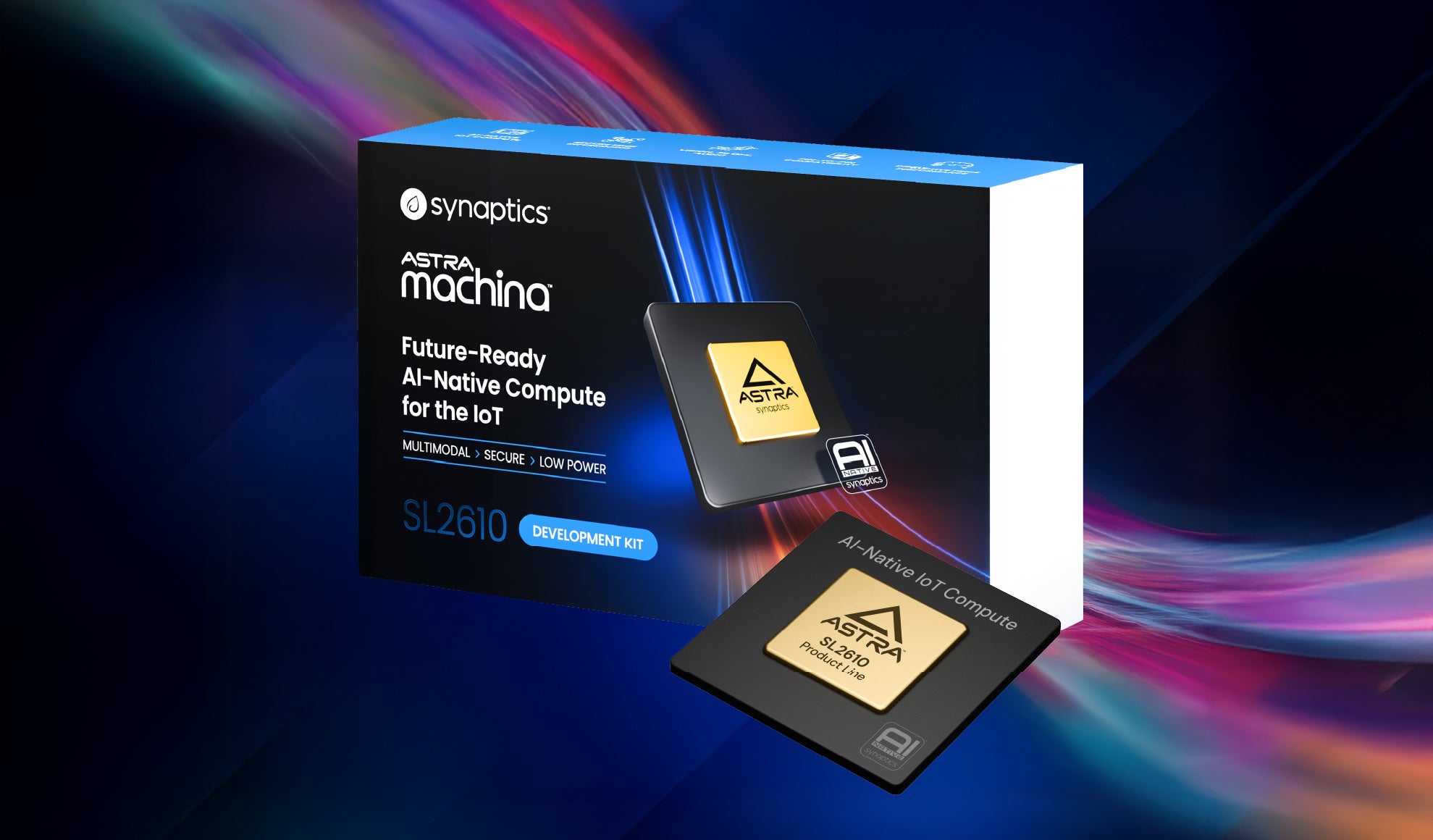There’s a growing tension in the world of connected products. On one side, engineers find themselves having to push microcontrollers far beyond their limits, resorting to bolted-on accelerators, extra parts and delicate pipelines just to keep pace with modern demands for User Interface (UI), camera, and voice capabilities. On the other side are heavy-duty application processors that introduce additional watts, cost and complexity that most products simply don't need. Engineers have been forced to choose between these two extremes, compromising on either performance or efficiency.
But what if there was another way? When Synaptics set out to design our latest processor, our goal was to address an unmet market need, while also delivering new levels of value to customers. We wanted to build the product that every embedded engineer always wanted.
So, we interviewed engineers, product managers, platform architects, and machine learning specialists to understand their goals and priorities. We reviewed their product roadmaps, then asked them what an ideal product would look like so we could build it for them. The result is the Synaptics Astra SL2610 lineup: a practical, right-sized processor line, purpose-built for Human-Machine Interface (HMI), vision, and voice applications at the Edge.
Why the Market Needs a Better Choice: The Software Dilemma
Today’s “simple” products are anything but. A modern device needs a fluid display, a touch UI that feels instantaneous, a camera for awareness or safety, and maybe a small transformer model to make voice commands feel natural and conversational. And all this needs to be delivered with secure connectivity and years of reliable operation.
In our voice of customer research, we found that the single biggest barrier to innovation isn’t hardware — it’s software. The complexity and cost of software is often the number one reason a customer will delay making significant changes to their platform. If they need to add one new feature that their current semiconductor vendor doesn’t support, the alternative is incredibly inefficient. Switching vendors can be extremely expensive because their software is different. Each vendor’s Linux distribution has its own proprietary customizations, and trying to port an entire software stack is a well-known challenge in which multiple tools are likely to fail.
The SL2610 was designed to solve this challenge. It’s not a single part. It's a product line of five distinct families that are pin-for-pin compatible—a rarity in the industry. This design gives customers tremendous software and hardware reuse. You enter the product line at one of five points and easily scale as your requirements evolve, adding or removing features to dial in the perfect price-performance point.
What We Built: A Balanced Platform for Real-World Products
We set out to build a balanced platform where the compute, graphics and AI capabilities work in harmony to create a product that meets the demands of today’s marketplace. The SL2610 architecture is built on four key pillars:
1. A Right-Sized NPU for On-Device AI
At this price point, our Neural Processing Unit (NPU) outperforms what on-paper specs suggest. On raw metrics, such as operations per second, it might not stand out. However, with our software tools, it achieves far more than you’d expect. It’s optimized for efficiency—think of it as getting more work done per clock cycle. It has all the headroom needed for key AI tasks like object detection, object classification, and small language models, without burning unnecessary power.
2. High-Frequency Arm® Application Cores
To ensure the whole system is fast and responsive, we included high-frequency Arm® cores that handle a Linux-class stack and fast control loops with ease.
3. A Modern 3D GPU
User experience is paramount. A modern 3D GPU ensures that HMIs feel crisp and fluid, not like a piece of legacy hardware.
4. Industrial I/O and Timing
This silicon is designed to be reliable in the real world, not just in the lab. With industrial-grade I/O and timing, it’s ready for deployment in factories, vehicles, buildings, and appliances.
A Deeper Dive into the NPU's Capabilities
Transformer Support
A key differentiator of the SL2610’s NPU is its built-in transformer capability. Transformers are the technology behind large language models like ChatGPT and Google Gemini, and they enable a huge leap forward in human-machine interaction. In the past, interacting with a device required speaking in broken, command-based phrases like “navigate to Central Park.” With the SL2610, interactions are natural and conversational.
Use Case Example (The Smart Espresso Machine)
Imagine walking up to your espresso machine in the morning. Today, you might have to push several buttons or pull out your phone to use a clunky Bluetooth app. Tomorrow, with a device powered by the SL2610, you could simply talk to it. A camera sensor or microphone performs vision or voice ID, recognizes you, and greets you by your name. You say, “Two shots of espresso, half sweet, with a little bit of milk," and the machine prepares your perfect drink, remembering your preferences for next time. No buttons, no phone — just a seamless, personalized interaction.
Privacy by Design
This entire interaction happens at the Edge, with no cloud connection required. All your personal data, like your coffee preferences, stays private and secure on the device. This is crucial for applications where privacy is a major concern, such as a doorbell camera or a personal health device.
The SL2610 Lineup: Choose Your Ideal Entry Point
The Astra SL2610 is a single platform expressed as five families, offering a clear entry point for any need. The entire lineup shares a single software stack and consistent developer experience, so your investment in one family follows you across the others.
- SL2611: This is the entry-level family, perfect for getting started with your first embedded Linux product. It’s HMI-first, designed for responsive touch and display with a lean BOM for cost-sensitive applications.
- SL2613: This family adds lite vision capabilities, making it ideal for camera-centric features like presence detection, occupancy sensing, and simple object classification.
- SL2615: This is the balanced workhorse of the lineup and the sweet spot in the middle. It’s the ideal choice when you need reliable HMI, camera, and voice capabilities together.
- SL2617: For more demanding vision applications, this family is vision-forward, offering more headroom and interfaces for richer camera pipelines and analytics at the edge.
- SL2619: At the high end, this family provides expanded connectivity and industrial options for gateways, transportation, and other demanding environments.
Built-in Security and Cost-Effectiveness
Security by Construction
With AI, security takes on a new dimension. It’s no longer just about protecting the device from being hacked, it’s also about protecting the AI model itself. We call this secure inferencing. Imagine a smart toaster with AI that perfectly toasts your bread. What if someone manipulated that AI model to change its definition of "brownness" to "blackness?" The device could become a fire hazard.
The SL2610 is designed to prevent this. Security starts from the moment the chip boots with a hardware root of trust and extends to a secure enclave (Arm PSA Level 3 on some variations) that is tamper-resistant and protects how the AI model is executed.
A Sane Bill of Materials (BOM)
We also know that cost is a critical factor for any real-world product. We specifically designed the SL2610 with hooks that allow our customers to design systems with a low-cost bill of materials, often more cost-effective than alternative solutions. This was one of the top priorities we heard from the engineers we interviewed.
The Synaptics Commitment: A Platform Company with a Robust Ecosystem
This launch represents more than just a new product. It demonstrates our focus on becoming a leading, long-term player in processors for the Edge. Synaptics has been a leader in this space for many years, but with the SL2610, we are making a definitive statement. This is the result of our customer-first engineering approach.
Great silicon also needs a great ecosystem to support it.
System-on-Modules (SoMs)
We have partnered with a strategic group of SoM manufacturers who provide production-ready modules. They remove the complexity of things like high-speed interfaces, allowing you to get started on your design quickly.
AI ISVs and Model Partners
While open-source AI models are a great starting point, most customers need help tuning them into production-grade solutions. Synaptics has a wealth of partners available to help customers accelerate their AI development and tune models for the specific needs of their application.
Global Channel
Our global distribution channel ensures that evaluation kits are accessible, and design support is available to you, anywhere in the world.
What the Market Demands—Delivered
The Astra SL2610 is the just-right Edge processor lineup for any product that needs a modern UI, a camera, and on-device intelligence without drifting into a laptop-class bill of materials. It is efficient and built for the realities of shipping hardware.
We invite you to see for yourself. Ask for an Evaluation Kit (EVK), download the SDK, and bring a real workload. We’re ready to meet you where you are and help you ship a product your customers will love.

